
views
Removing a Broken Window Pane

Scrape away the putty around the broken window pane. Use a utility knife, chisel, or putty knife to scrape away the putty surrounding the broken pane. This will loosen the glass and will allow you to remove it easily. Wear thick work gloves and goggles for safety.
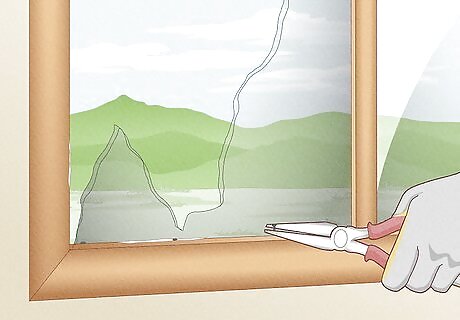
Remove any nails or clips with pliers. Some windows will have nails or clips that help hold the pane in place. Use a set of pliers to grab onto any nails or clips in the frame and pull them out.

Pull all the shards of glass out of the window frame. Wiggle the pieces of glass that are still stuck to the frame until they come loose. Once they are loose, remove the shards of glass and dispose of them. Continue doing this until there is no more glass in the frame.
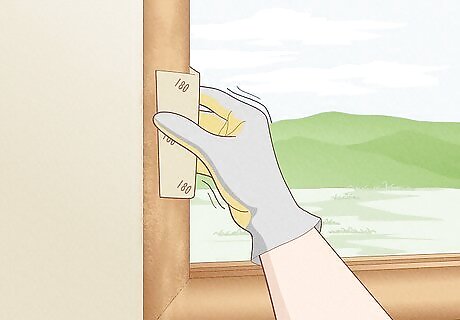
Sand the area around the broken window with 100-180 grit sandpaper. Smooth out the area around the broken window pane by going back and forth over any remaining putty or sealant. Once the area is smoothed out, wipe the area down with a damp rag to remove any excess particles left over from sanding.
Replacing a Broken Window Pane
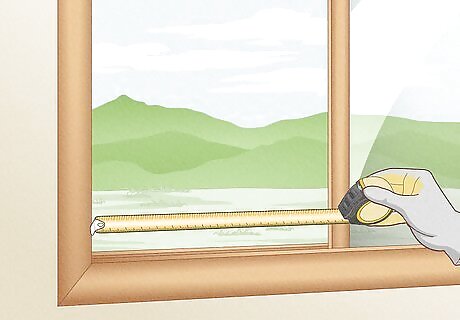
Measure the area around the broken window pane. Use a tape measure to get the length and width of the window frame. Measuring the area will help you determine how big your new piece of glass should be. Subtract ⁄8 inch (0.32 cm) from the measurement. The additional space will ensure that the glass will fit in the window and won't crack if the frame expands during cold weather.
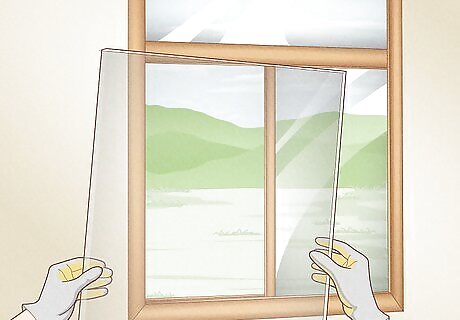
Purchase a new pane of glass. Go to a hardware or glass store with your measurements and buy a new piece of glass. They will cut your glass to your specifications.
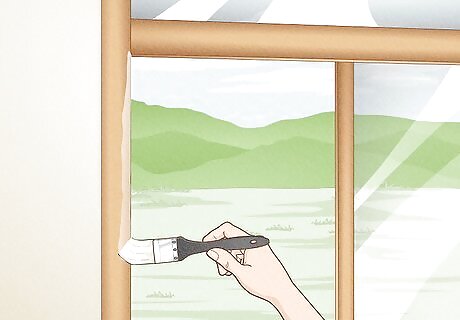
If the frame is made out of wood, use a painter's brush to apply a layer of wood sealer around the broken window frame. Let the sealer dry for one or two hours before moving onto the next step. Wood sealer will help the putty or glazing compound adhere to the wood and will help with weather-proofing your windows.
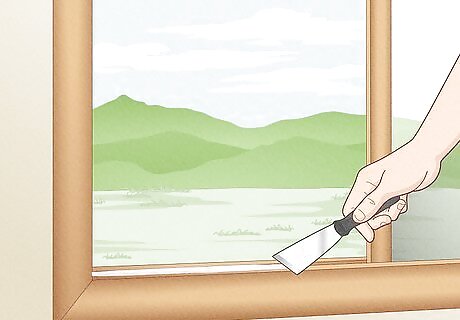
Apply putty or a glazing compound around the frame. This will help hold your new pane of glass in place. If you're using putty, roll it in your hands to warm it up, then apply it to the interior of the frame. If you're using a glazing compound, squeeze a tube of the compound onto the frame, around the empty hole. If your compound came in a container, use a putty knife to apply it. Don't worry about laying too much putty or compound because you'll be scraping the excess away later. You can purchase putty or a glazing compound from the hardware store or online.

Push your new pane of glass into the empty opening. Take your new piece of glass and carefully press it into the opening. The glass should press against the putty and adhere to it.
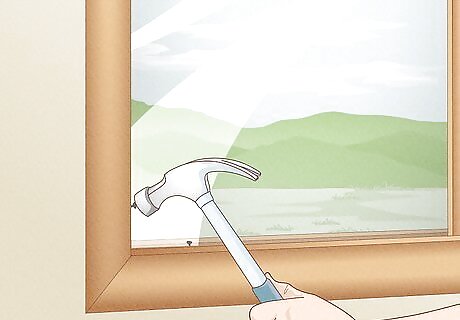
Reinsert any nails or clips that you removed earlier. Replace the clips or nails that you removed earlier by lightly tapping them back into the frame. This will help your pane of glass stay in place.
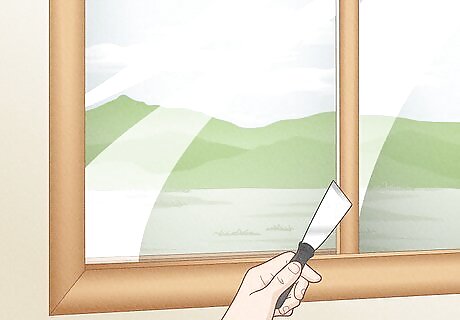
Apply putty or glazing compound around the new window. Apply a layer of putty or compound around the edges of the new pane of glass. This will ensure that it's held in place with the putty on both sides of the window and will hold your new glass in place.
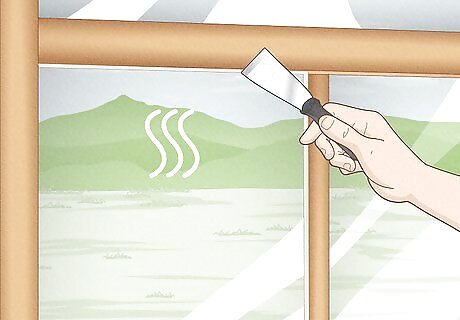
Smooth the putty out and let it dry. Use a putty knife to smooth out the compound around the new window pane. Remove any excess putty or compound so that it runs flush with the frame and looks clean. Allow the putty to dry overnight so that it sets. Remember to smooth the putty on both sides of the window.
Performing Temporary Fixes

Apply a piece of masking tape to both sides of a crack. Get a roll of masking tape and cut two pieces that are large enough to cover the entire crack or hole in your window. Apply the tape over the crack, then go to the other side of the window and place another piece of tape on the other side of the crack. Applying tape to the crack should temporarily stop the window from cracking further. EXPERT TIP Douglass Brown Douglass Brown Glassblowing Expert Douglass Brown is a Glassblowing Expert based in Half Moon Bay, California. He has over 25 years of experience as a glass artist, and is the owner and operator of 2 glass blowing studios in the San Francisco Bay Area, Half Moon Bay Art Glass and Mare Island Art Glass. Douglass believes in sharing hot glass experiences with anyone who wants to learn about the processes of blowing and sculpting glass. When not teaching, Douglass creates glass art that is a mix of his takes on nature and functional glassware. He has also created the Glass Troubadours, which is a mobile glass blowing studio that hosts parties, events, and visits craft shows. Douglass Brown Douglass Brown Glassblowing Expert Broken glass loses a lot of its qualities. You might be able to glue it back together, but it will not be as strong and stable as it was before. For safety reasons, you will need to replace the broken glass.
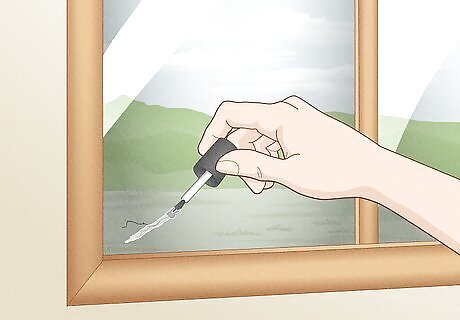
Paint over small holes or cracks with a clear nail polish. Dip the nail polish brush into the polish and apply it over the cracks or holes to fill them in. Let the polish dry, then repeat the process three to four times to completely seal off the cracks or holes in your window. Clear nail polish will only seal small cracks and holes in your window and shouldn't be used for windows that have sustained significant damage.
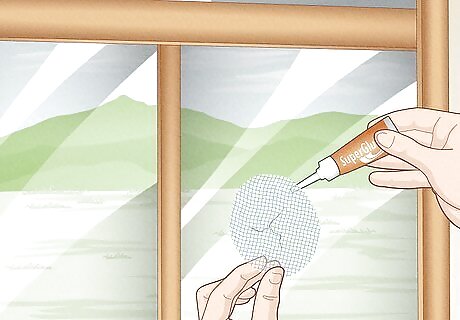
Glue a mesh patch over the cracks. You can use the mesh from a pair of nylon stockings or pantyhose. Cut a square from the fabric that's large enough to fit over the entire crack. Apply super glue around the edges of the mesh patch and stick it on top of the crack in your window. Hold the mesh patch there for two to three minutes or until the glue dries. This will help keep bugs out of your house and will reduce drafts caused by cold air.

Tape a piece of thick plastic around the hole. If you have a larger hole in your window and don't have the time to replace it, you can stop unwanted airflow through the hole. Cut a square of plastic from a tarp or a thick trash bag that's large enough to fit over the hole. Apply masking or duct tape around the edges of the plastic, sealing it onto your window.
















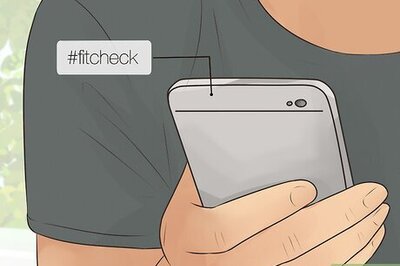
Comments
0 comment